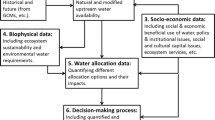Abstract
This paper describes a water accounting system (WAS) that has been developed as an innovative new tool for strategic long-term water management. The WAS incorporates both disaggregated water use and availability, provides a comprehensive and consistent historical database, and can integrate climate and hydrological model outputs for the exploration of scenarios. It has been established and tested for the state of Victoria in Australia, and can be extended to cover other or all regions of Australia. The WAS is implemented using stock-and-flow dynamics, currently employing major river basins as the spatial units and a yearly time step. While this system shares features with system dynamics, learning is enhanced and strategic management of water resources is improved by application of a Design Approach and the structure of the WAS. We compare the WAS with other relevant accounting systems and outline its benefits, particularly the potential for resolving tensions between water supply and demand. Integrated management is facilitated by combination with other stocks and flows frameworks that provide data on key drivers such as demography, land-use and electricity production.
Similar content being viewed by others
References
ABS (2006) Water account Australia 2004–05. Australian Bureau of Statistics
Baynes TM, Turner GM, West J (2009) Historical calibration of a water accounting system; CSIRO SEED Working Paper 28 <http://www.csiro.au/resources/seed.html>
DRW (1989) Water Victoria: a resource handbook. State Government of Victoria Department of Water Resources, Melbourne
Dunlop M, Turner G, Foran B, Poldy F (2002) Decision points for land and water futures. CSIRO Sustainable Ecosystems, Resource Futures Program, National Futures, Canberra
Foran B (2003) Between a rock and a hard place: Australia’s population options to 2050 and beyond. In: Vizard S, Martin HJ, Watts T (eds) Australia’s population challenge: the 2002 Australian population summit. Penguin, Melbourne, pp 117–139
Foran B, Poldy F (2001) Modelling physical realities: designing and testing future options to 2050 and beyond. In: Venning J, Higgins J (eds) Towards sustainability: emerging systems for informing sustainable development. UNSW Press, Sydney, pp 165–195
Foran B, Poldy F (2002) Future dilemmas: options to 2050 for Australia’s population, technology, resources and environment. Report to the Department of Immigration and Multicultural and Indigenous Affairs, CSIRO Sustainable Ecosystems, Canberra
Gault FD, Hamilton KE, Hoffman RB, McInnis BC (1987) The design approach to socio-economic modelling. Futures 19(1):3–25. doi:10.1016/0016-3287(87)90036-X
Hameed T, Podger G (2001) Use of the IQQM simulation model for planning and management of a regulated river system. Integrated Water Resources Management (272):83–89
Jones RN, Durack PJ (2005) Estimating the impacts of climate change on Victoria’s runoff using a hydrological sensitivity model. CSIRO Atmospheric Research, Melbourne
Kearney B, Foran B, Poldy F, Lowe DB (2003) Modelling Australia’s fisheries to 2050: policy and management implications. Fisheries Research and Development Corporation
Kenway S, Turner G, Cook S, Baynes TM (2008) Water-energy futures for Melbourne—the effect of water strategies, water use and urban form. CSIRO Water for a Healthy Country
Kirby M, Van Dijk AIJM, Mainuddin M, Peña-Arancibia J, Guerschman J-P, Liu Y, Marvanek S, McJannet DL, Paydar Z, McVicar TR, Van Niel TG, Li LT (2008) River water balance accounting to evaluate model adequacy and uncertainty in climate and development scenario assessment. In: Water down under. Adelaide
Loucks DP, van Beek E (2005) Water resources systems planning and management: an introduction to methods, models and applications. In: Studies and reports in hydrology. Publishing U, UNESCO Publishing, Paris
Lowe D, Poldy F, Kearney B, Foran B, Turner G (2003) Australian fish futures: 2020 and beyond. Report to the Fisheries Research and Development Corporation, CSIRO Sustainable Ecosystems, Resource Futures Program, National Futures
Neal B, Radcliffe J, McMahon T, Nathan R (2007) Urban water—review of water supply planning for Australia’s non-metropolitan urban water utilities. The Australian Academy of Technological Sciences and Engineering, Parkville, Victoria
O’Neill G (2008) Supermodelling the Murray–Darling. In: Ecos, pp 8–11
Perera BJC, James B, Kularathna MDU (2005) Computer software tool REALM for sustainable water allocation and management. J Environ Manag 77(4):291–300. doi:10.1016/j.jenvman.2005.06.014
Poldy F, Foran B, Conroy J (2000) Future options to 2050: Australian stocks and flows framework. Report to Department of Immigration and Multicultural Affairs; 00/04, CSIRO Sustainable Ecosystems (previously Wildlife and Ecology), Resource Futures Program, National Futures, Canberra
Silva-Hidalgo H, Martin-Dominguez IR, Alarcon-Herrera MT, Alfredo G-O (2008) Mathematical modelling for the integrated management of water resources in hydrological basins. Water Resour Manag 23(4):721–730
SKM (2006) Australian Water Resources 2005: Supporting information—level 2 data request. National Water Commission
Turner GM, Baynes TM, West J (2007a) Combined pressures and climate change impacts on the Victorian water system and possible responses. In: Oxley L, Kulasiri D (eds) MODSIM 2007—International congress on modelling and simulation; land, water & environmental management: integrated systems from sustainability. Christchurch, NZ, pp 567–573
Turner GM, Baynes TM, West J (2007b) Victorian regional scenarios—interactions of demographics, land-use, electricity, water and climate systems. CSIRO Sustainable Ecosystems, Canberra
UNSD (2007) System of environmental–economic accounting for water. United Nations Statistical Division
whatIf (2008) whatIf Technologies Incorporated. Available from: http://www.whatiftechnologies.com
Winz I, Brierley G, Trowsdale S (2008) The use of system dynamics simulation in water resource management. Water Resources Management
Zhang L, Dawes WR, Walker GR (1999) Predicting the effect of vegetation changes on catchment average water balance. Cooperative Research Centre for Catchment Hydrology, and CSIRO Land and Water
Zhang L, Dowling T, Hocking M, Morris J, Adams G, Hickel K, Best A, Vertessy R (2003) Predicting the effects of large-scale afforestation on annual flow regime and water allocation: an example for the Goulburn–Broken catchments. Cooperative Research Centre for Catchment Hydrology
Author information
Authors and Affiliations
Corresponding author
Electronic Supplementary Material
Below is the linked to the Electronic supplementary material.
Rights and permissions
About this article
Cite this article
Turner, G.M., Baynes, T.M. & McInnis, B.C. A Water Accounting System for Strategic Water Management. Water Resour Manage 24, 513–545 (2010). https://doi.org/10.1007/s11269-009-9457-7
Received:
Accepted:
Published:
Issue Date:
DOI: https://doi.org/10.1007/s11269-009-9457-7




